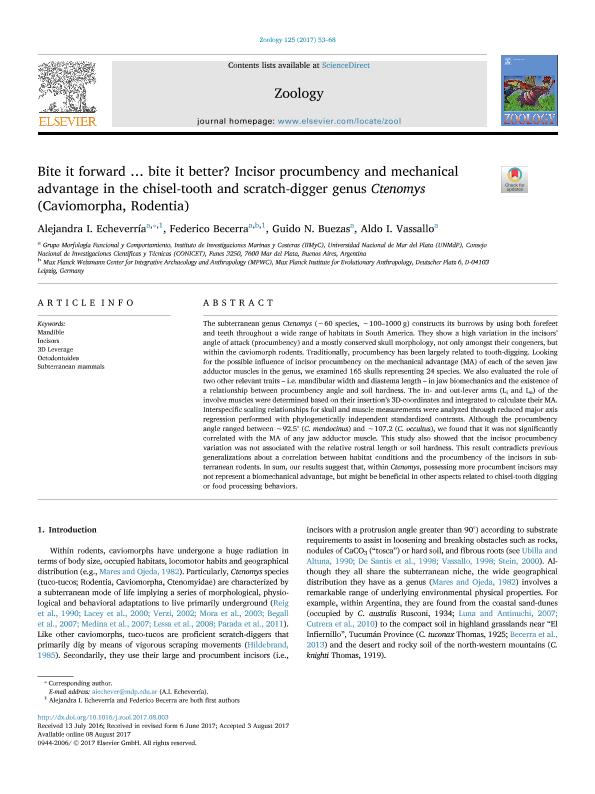Mostrar el registro sencillo del ítem
dc.contributor.author
Echeverría, Alejandra Isabel

dc.contributor.author
Becerra, Federico

dc.contributor.author
Buezas, Guido Nicolás

dc.contributor.author
Vassallo, Aldo Iván

dc.date.available
2018-08-22T14:22:41Z
dc.date.issued
2017-12
dc.identifier.citation
Echeverría, Alejandra Isabel; Becerra, Federico; Buezas, Guido Nicolás; Vassallo, Aldo Iván; Bite it forward … bite it better? Incisor procumbency and mechanical advantage in the chisel-tooth and scratch-digger genus Ctenomys (Caviomorpha, Rodentia); Elsevier Gmbh; Zoology; 125; 12-2017; 53-68
dc.identifier.issn
0944-2006
dc.identifier.uri
http://hdl.handle.net/11336/56527
dc.description.abstract
The subterranean genus Ctenomys (∼60 species, ∼100–1000 g) constructs its burrows by using both forefeet and teeth throughout a wide range of habitats in South America. They show a high variation in the incisors’ angle of attack (procumbency) and a mostly conserved skull morphology, not only amongst their congeners, but within the caviomorph rodents. Traditionally, procumbency has been largely related to tooth-digging. Looking for the possible influence of incisor procumbency on the mechanical advantage (MA) of each of the seven jaw adductor muscles in the genus, we examined 165 skulls representing 24 species. We also evaluated the role of two other relevant traits – i.e. mandibular width and diastema length – in jaw biomechanics and the existence of a relationship between procumbency angle and soil hardness. The in- and out-lever arms (Li and Lo) of the involve muscles were determined based on their insertion's 3D-coordinates and integrated to calculate their MA. Interspecific scaling relationships for skull and muscle measurements were analyzed through reduced major axis regression performed with phylogenetically independent standardized contrasts. Although the procumbency angle ranged between ∼92.5° (C. mendocinus) and ∼107.2 (C. occultus), we found that it was not significantly correlated with the MA of any jaw adductor muscle. This study also showed that the incisor procumbency variation was not associated with the relative rostral length or soil hardness. This result contradicts previous generalizations about a correlation between habitat conditions and the procumbency of the incisors in subterranean rodents. In sum, our results suggest that, within Ctenomys, possessing more procumbent incisors may not represent a biomechanical advantage, but might be beneficial in other aspects related to chisel-tooth digging or food processing behaviors.
dc.format
application/pdf
dc.language.iso
eng
dc.publisher
Elsevier Gmbh

dc.rights
info:eu-repo/semantics/openAccess
dc.rights.uri
https://creativecommons.org/licenses/by-nc-sa/2.5/ar/
dc.subject
3D LEVERAGE
dc.subject
INCISORS
dc.subject
MANDIBLE
dc.subject
OCTODONTOIDEA
dc.subject
SUBTERRANEAN MAMMALS
dc.subject.classification
Otras Ciencias Biológicas

dc.subject.classification
Ciencias Biológicas

dc.subject.classification
CIENCIAS NATURALES Y EXACTAS

dc.title
Bite it forward … bite it better? Incisor procumbency and mechanical advantage in the chisel-tooth and scratch-digger genus Ctenomys (Caviomorpha, Rodentia)
dc.type
info:eu-repo/semantics/article
dc.type
info:ar-repo/semantics/artículo
dc.type
info:eu-repo/semantics/publishedVersion
dc.date.updated
2018-08-21T13:47:21Z
dc.journal.volume
125
dc.journal.pagination
53-68
dc.journal.pais
Alemania

dc.journal.ciudad
Jena
dc.description.fil
Fil: Echeverría, Alejandra Isabel. Consejo Nacional de Investigaciones Científicas y Técnicas. Centro Científico Tecnológico Conicet - Mar del Plata. Instituto de Investigaciones Marinas y Costeras. Universidad Nacional de Mar del Plata. Facultad de Ciencia Exactas y Naturales. Instituto de Investigaciones Marinas y Costeras; Argentina
dc.description.fil
Fil: Becerra, Federico. Consejo Nacional de Investigaciones Científicas y Técnicas. Centro Científico Tecnológico Conicet - Mar del Plata. Instituto de Investigaciones Marinas y Costeras. Universidad Nacional de Mar del Plata. Facultad de Ciencia Exactas y Naturales. Instituto de Investigaciones Marinas y Costeras; Argentina. Max Planck Institute for Evolutionary Anthropology; Alemania
dc.description.fil
Fil: Buezas, Guido Nicolás. Consejo Nacional de Investigaciones Científicas y Técnicas. Centro Científico Tecnológico Conicet - Mar del Plata. Instituto de Investigaciones Marinas y Costeras. Universidad Nacional de Mar del Plata. Facultad de Ciencia Exactas y Naturales. Instituto de Investigaciones Marinas y Costeras; Argentina
dc.description.fil
Fil: Vassallo, Aldo Iván. Consejo Nacional de Investigaciones Científicas y Técnicas. Centro Científico Tecnológico Conicet - Mar del Plata. Instituto de Investigaciones Marinas y Costeras. Universidad Nacional de Mar del Plata. Facultad de Ciencia Exactas y Naturales. Instituto de Investigaciones Marinas y Costeras; Argentina
dc.journal.title
Zoology

dc.relation.alternativeid
info:eu-repo/semantics/altIdentifier/doi/https://dx.doi.org/10.1016/j.zool.2017.08.003
dc.relation.alternativeid
info:eu-repo/semantics/altIdentifier/url/https://www.sciencedirect.com/science/article/pii/S0944200617301769
Archivos asociados
